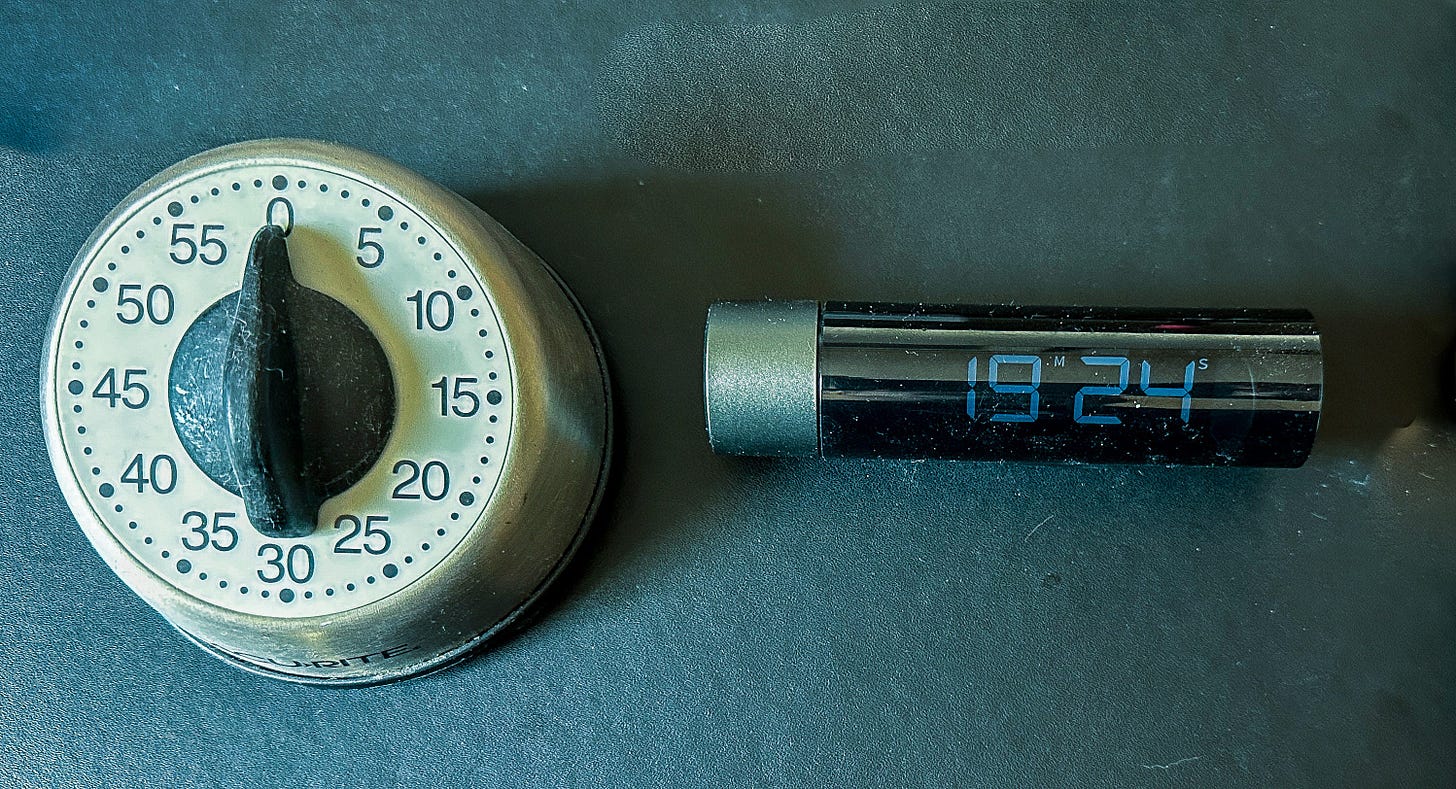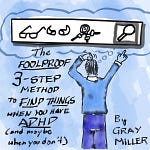I have two timers on my desk. They serve the same purpose: pomodoros, those 20-minute deep-work sessions named after a tomato.
One is beautifully analog — an industrial looking gray-and-black twist-dial mechanism that I’ve cranked so many times that it’s no longer really accurate to within more than three or four minutes. When you wind it, it gives off a smooth tickticktickticktickticktick culminating in a bright non-digital ding!
I hardly ever use it.
The other timer is a smooth black cylinder with a gray cap that you twist to set the time. There’s a digital readout that flips so you can’t ever have the timer upside down. You can see the numbers counting down, perched on a little magnetic stand to hold it. It gives off a piercing and persistent beep that penetrates my headphones when the Pomodoro’s done.
I don’t use that much, either. But I do Pomos all the time. I’m doing one now.
But lately they’ve become a lot more important, due to my recent diagnosis of ADHD and the realization that many of my struggles with focus and productivity was due to time blindness.
Turns out the cool life hacks I’ve tried for keeping track of my days were less curiosity and more my brain desperately looking for coping mechanisms.
Now timers are one of the most important tools I use as a scaffold for my executive function. But in spite of these timers in easy reach, when I want to do a pomodoro I just speak a magic phrase:
“Hey Siri. Set a timer for 20 minutes.”
There’s nowhere in my home — where I work — that Apple’s voice assistant won’t hear that. She responds “20 minutes. Starting now,” and I can relax into work until a melodious high-fidelity chime nudges me to stop.
With “raise to speak” and “listen for “hey Siri” set up on my watch, it works even when I’m not home, giving a nice little silent buzz when the Pomo is done.
Painless. Unobtrusive. Simple.
My other timers are simple too — but not as simple as just saying the magic words.
And that’s why those don’t get used.
Ideas are Pokemon: Gotta catch ’em all!
There’s a similar arc of “desperately looking for executive function support” disguised as “curiosity” in my personal knowledge management.
I’ve built a second brain and linked my thinking and shipped thirty for thirty, with Notion and Obsidian and Miro and Notability and Evernote and Craft and more.
I love the design of Moleskine’s Journey app. It does everything I might want for my daily routines and even has some project management tools.
The problem is trying to use it when an idea or task pops into my brain.
By the time I:
Find my phone.
Turn on the phone.
Unlock my phone.
Find the app.
Open the app.
Find the part of the app that stores ideas or tasks.
Start a new entry.
Configure, tag, add a due date, or whatever.
Finally start typing.
…more often than not the idea is gone.
Or worse, I’ll have the idea, think about how much trouble it would be to go through all those steps, and tell myself the big lie: “Oh, I’ll just remember that later.”
Meanwhile, the process with my notebook when I have an idea:
Find the notebook (usually within reach, always with a pen attached).
Open to the next blank page (always marked by the little cloth ribbon.)
Write a dash ( — ) followed by whatever the thought or idea is.
A notebook is not the answer for everyone, everywhere, all the time — but there’s a reason it’s been used for thousands of years.
Applying Occam’s Gizmo
“Occam’s Gizmo” (because “Occam’s Tool” has some unfortunate connotations) is my name for this lesson I’ve learned the hard way:
Most of the time, the best tool for the job is the simplest.
The first question to ask about any new app or device is: how will this complicate my life?
Is it a ten-step process like the Journey app? Will you need to make sure your device is charged? Do you have to be connected to the internet to use it (I’m looking at you, Notion)? Is there a monthly subscription cost? Are they going to show you ads? What about privacy?
You may go through all this and still decide the app is worth the complications — but that will be an informed, personal decision, instead of a blind belief in a catchy ad campaign.
Or maybe you just enjoy using the app. UX designers are talented folks, and humans like using things that are beautiful. (Call that Occam’s Pretty, maybe.)
When I hear about a Great New App that will Organize My Life and Achieve My Ultimate Success, thanks to Occam’s Gizmo, I’m skeptical.
Is it really likely that the best use of my time will be to learn the interface, transfer my data, and figure out workflows?
What else could I get done in that time? What else could I use that money for?
Or is the attraction just an excuse to get that retail dopamine, or procrastinate on some other project with the hollow promise of “this will get things done even faster!”
Occam’s Gizmo gives you time. Time to sleep, dance, watch YouTube, send a flirty text that will brighten somebody’s day.
Who knows? You might even decide to get things done.














Share this post